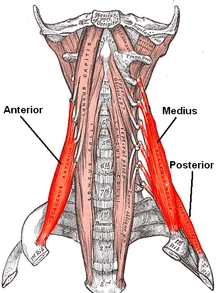It happens that the true cause of pain is extremely difficult to find. The reason may lie in trigger points. Trigger points or muscle nodules – a common cause of persistent and unpleasant pain, the cause of which is not always possible to find out. There are thirteen points that can be massaged by exerting pressure on the muscles. One of these points is located in the group of scalene muscles. What are these muscles, where are they located and what types of pain and symptoms can cause trigger points located in them – estet-portal.com will tell about all this.
Ladder muscles – specific muscle group
The scalene muscles are often the cause of neck pain and headaches. And this is just the tip of the iceberg. The scalene muscles are often the site of a cluster of trigger points that cause a variety of symptoms. The primary mechanism of such influence – This is referred pain. Pain in the scalene muscles can be felt anywhere but in the very muscles – for example, in the arm or chest.
 Effect of referred pain – it is quite normal for muscle pain or other type of internal pain. For example, pain during a heart attack can radiate to the shoulder and arm. However, scalene muscle pain can lead to complex, varied, and extensive patterns of referred pain. The symptoms can be so varied that not only a simple person, even a doctor cannot always guess that the scalene muscles are their source.
Effect of referred pain – it is quite normal for muscle pain or other type of internal pain. For example, pain during a heart attack can radiate to the shoulder and arm. However, scalene muscle pain can lead to complex, varied, and extensive patterns of referred pain. The symptoms can be so varied that not only a simple person, even a doctor cannot always guess that the scalene muscles are their source.
Trigger points in the scalene muscles – unexpected effect
Trigger points in the scalene muscles can also affect voice, swallowing, hearing, emotions or sensations in the head, sinuses, teeth in quite interesting ways. Scalene trigger points can cause the following problems:
- deterioration of the voice of professional singers;
- acute chronic sinus infections;
- Obstruction of the flow of blood and nerve signals to the arm due to impact on the brachial artery and brachial nerve plexus;
- feeling of a lump in the throat without any formations.
The scalene trigger points themselves are not the root cause of fairly serious problems, but they can exacerbate problems in a certain area, acting as a terror-inducing gang in the neighborhood. And the "ringleader" such a gang can be called the anterior scalene muscle.
Anatomy of the Bermuda triangle of your body – scalene muscles
The scalene muscles arise from the sides of the neck bones and attach to the ribs. The scalene muscle group consists of three muscles:
- scalenus anterior;
- scalenus medius;
- scalenus posterior.
As a rule, they are attached to the sides of the cervical vertebrae and to the upper ribs. The scalene muscles are responsible for the lateral movements of the head. They also move the neck, as well as the respiratory muscles, as they pull the ribs up.
Another interesting feature of the scalene muscles is that in some people they run between the ribs and attach directly to the lungs.
The scalene muscle group itself is not difficult to find, but it is the details of these muscles that are of particular interest. The scalene muscles fill the space between three structures:
- collarbone;
- trapezius muscle;
- sternocleidomastoid muscle.
These three structures form the "Bermuda" the triangle in which the scalene muscles are located.
Trigger points in this area may be responsible for:
- pain in the upper back (especially on the inside of the shoulder blade);
- pain in the neck;
- pain in the side of the face;
- pain in the upper chest;
- shoulder pain;
- pain in the arms;
- scalenus syndrome;
- lump in throat;
- hoarseness;
- temporomandibular joint syndrome.
The massage of trigger points located in the scalene muscle group, which estet-portal.com will talk about in the next article, will help get rid of such problems.








Add a comment